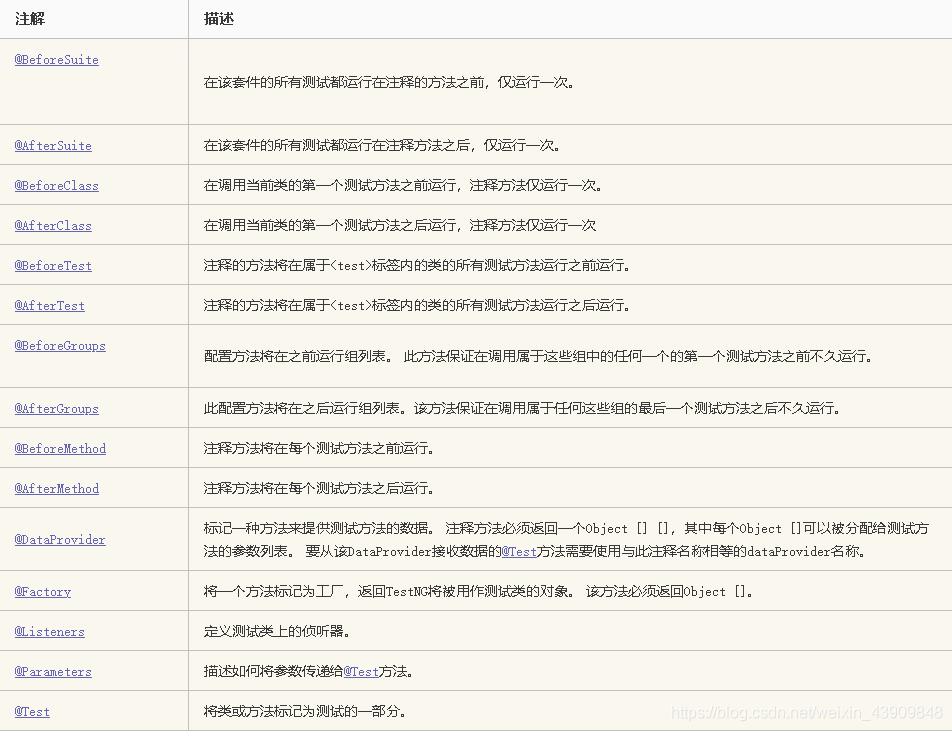社区微信群开通啦,扫一扫抢先加入社区官方微信群

社区微信群
社区微信群开通啦,扫一扫抢先加入社区官方微信群

社区微信群
TestNG是一个比Junit功能更强大的测试框架。常用方法如下:
本次使用百度的登录作为案例,搭建一个完整的测试框架并进行登录测试。源码地址:百度登录自动化
目录结构如图
cases:测试用例
common:公用方法
datas:存放数据,配置文件以及测试表格文档
utils:工具类
主要是selenium+testNG+ReporterNG的依赖
<dependencies>
<dependency>
<groupId>org.apache.poi</groupId>
<artifactId>poi</artifactId>
<version>3.9</version>
</dependency>
<dependency>
<groupId>org.apache.poi</groupId>
<artifactId>poi-ooxml</artifactId>
<version>3.9</version>
</dependency>
<dependency>
<groupId>junit</groupId>
<artifactId>junit</artifactId>
<version>4.11</version>
<scope>test</scope>
</dependency>
<dependency>
<groupId>org.seleniumhq.selenium</groupId>
<artifactId>selenium-java</artifactId>
<version>3.4.0</version>
</dependency>
<dependency>
<groupId>org.uncommons</groupId>
<artifactId>reportng</artifactId>
<version>1.1.4</version>
<exclusions>
<exclusion>
<groupId>org.testng</groupId>
<artifactId>testng</artifactId>
</exclusion>
</exclusions>
</dependency>
<dependency>
<groupId>org.testng</groupId>
<artifactId>testng</artifactId>
<version>6.10</version>
<scope>test</scope>
</dependency>
<dependency>
<groupId>com.google.inject</groupId>
<artifactId>guice</artifactId>
<version>4.1.0</version>
</dependency>
</dependencies>
<build>
<pluginManagement><!-- lock down plugins versions to avoid using Maven defaults (may be moved to parent pom) -->
<plugins>
<!-- clean lifecycle, see https://maven.apache.org/ref/current/maven-core/lifecycles.html#clean_Lifecycle -->
<plugin>
<artifactId>maven-clean-plugin</artifactId>
<version>3.1.0</version>
</plugin>
<!-- default lifecycle, jar packaging: see https://maven.apache.org/ref/current/maven-core/default-bindings.html#Plugin_bindings_for_jar_packaging -->
<plugin>
<artifactId>maven-resources-plugin</artifactId>
<version>3.0.2</version>
</plugin>
<plugin>
<groupId>org.apache.maven.plugins</groupId>
<artifactId>maven-compiler-plugin</artifactId>
<version>3.8.0</version>
<configuration>
<source>8</source>
<target>8</target>
</configuration>
</plugin>
<plugin>
<groupId>org.apache.maven.plugins</groupId>
<artifactId>maven-surefire-plugin</artifactId>
<version>2.22.1</version>
<configuration>
<skipTests>false</skipTests>
<suiteXmlFiles>
<suiteXmlFile>testng.xml</suiteXmlFile>
</suiteXmlFiles>
<!-- ReportNG配置 -->
<properties>
<property>
<name>usedefaultlisteners</name>
<value>false</value>
</property>
<property>
<name>listener</name>
<value>org.uncommons.reportng.HTMLReporter,org.uncommons.reportng.JUnitXMLReporter</value>
</property>
</properties>
<workingDirectory>target/</workingDirectory>
</configuration>
</plugin>
<plugin>
<artifactId>maven-jar-plugin</artifactId>
<version>3.0.2</version>
</plugin>
<plugin>
<artifactId>maven-install-plugin</artifactId>
<version>2.5.2</version>
</plugin>
<plugin>
<artifactId>maven-deploy-plugin</artifactId>
<version>2.8.2</version>
</plugin>
<!-- site lifecycle, see https://maven.apache.org/ref/current/maven-core/lifecycles.html#site_Lifecycle -->
<plugin>
<artifactId>maven-site-plugin</artifactId>
<version>3.7.1</version>
</plugin>
<plugin>
<artifactId>maven-project-info-reports-plugin</artifactId>
<version>3.0.0</version>
</plugin>
</plugins>
</pluginManagement>
</build>
(1)首先下载对应版本的浏览器的驱动,我这里用的是chorme
chorme驱动下载
放在resources下面
(2)在datas下面新建一个baseUrl.properties来配置存放我们要测试的网站的url
baseUrl=https://192.168.1.20:7090 //url根据自己的需要来
(3)在datas下面新建一个xlsx文件存放我们的测试数据(本文采用读取配置生成测试报告的方式测试)
TestData.xlsx内容如下:(这里只是用登录作为例子,很多时候我们可以将需要的数据例如xpath等等存入excel读取,根据需求填写表头)账号密码请填写自己的
(4)在datas下面新建一个xlsx文件存放我们的测试报告文件
TestResult.xlsx
TestResult.xlsx内容如下:(可根据自己需求填写表头)
1.在utils中添加工具类
由于我们要用到ExcelReport进行读写excel文件,读取测试用例并生成测试报告,所以添加读取和写入excel的工具类
ExcelReport.java
public class ExcelReport {
public static int rowNumber = 1;
public static void main(String[] args) {
writeExcel("test","Login","testLoginFail01","注释","pass","");
}
/**
*
* @param packageName : 包名
* @param className : 类名
* @param methodName :方法名
* @param remark : 注释
* @param result : 结果 pass fail
* @param reason :原因 pass 则为空 ,fail则有失败原因
*/
public static void writeExcel(String packageName , String className, String methodName , String remark , String result , String reason){
try{
/**
* 可以尝试,每次都生成不同的excel文档,往里面添加内容,但是需要office excel
*/
//report生成测试报告文件的路径
String path = "src/test/java/com/test/datas/TestResult.xlsx" ;
XSSFWorkbook wb = new XSSFWorkbook(new FileInputStream(path));
XSSFSheet sheet=wb.getSheetAt(0);
//获得EXCEL行数
int rowNums=sheet.getLastRowNum();
// System.out.println("多少行:" +rowNums);
//往sheet中追加一行数据
int rowCurrentNumber = rowNums+1;
sheet.createRow(rowCurrentNumber);
XSSFRow row = sheet.getRow(rowCurrentNumber);
//格式
CellStyle cellStyle2=wb.createCellStyle();
cellStyle2.setFillForegroundColor(IndexedColors.RED.getIndex()); // 前景色
cellStyle2.setFillPattern(CellStyle.SOLID_FOREGROUND);
cellStyle2.setBorderBottom(CellStyle.BORDER_THIN); // 底部边框
if(row != null){
//System.out.println("行不为空!" );
Date now = new Date();
SimpleDateFormat dateFormat = new SimpleDateFormat("yyyy/MM/dd HH:mm:ss");//可以任意地修改日期格式
String currentTime = dateFormat.format( now );
//创建单元格并赋值
row.createCell(0).setCellValue(currentTime);
row.createCell(1).setCellValue(packageName);
row.createCell(2).setCellValue(className);
row.createCell(3).setCellValue(methodName);
row.createCell(4).setCellValue(remark);
row.createCell(5).setCellValue(result);
if(result.equals("fail")){
row.getCell(5).setCellStyle(cellStyle2);
}
row.createCell(6).setCellValue(reason);
}else{
//System.out.println("行为空!" );
}
FileOutputStream os = new FileOutputStream(path);
wb.write(os);//一定要写这句代码,否则无法将数据写入excel文档中
os.close();
}catch(Exception e){
e.printStackTrace();
}
}
}
ReadExcel.java
public class ReadExcel {
public static Object[][] getData(String filePath, String fileName, String sheetName) throws IOException {
File file = new File(filePath + "\" + fileName);
//创建FileInputStream对象用于读取Excel文件
FileInputStream inputStream = new FileInputStream(file);
//声明Workbook对象
Workbook workbook = null;
//获取文件名参数的扩展名,判断是.xlsx文件还是.xls文件
String fileExtensionName = fileName.substring(fileName.indexOf("."));
//如果是.xlsx,则用XSSFWorkbook对象进行实例化,如果是.xls则使用HSSFWorkbook对象进行实例化
if (fileExtensionName.equals(".xlsx")){
workbook = new XSSFWorkbook(inputStream);
}
else if (fileExtensionName.equals(".xls")) {
workbook = new HSSFWorkbook(inputStream);
}
//通过sheetName参数生成Sheet对象
Sheet sheet = workbook.getSheet(sheetName);
//获取Excel数据文件Sheet1中数据的行数,getLastRowNum方法获取数据的最后一行行号
//getFirstRowNum方法获取数据的第一行行号,相减之后算出数据的行数
//Excel行和列都是从0开始
int rowCount = sheet.getLastRowNum()-sheet.getFirstRowNum();
//创建名为records的list对象来存储从Excel数据文件读取的数据
List<Object[]> records = new ArrayList<Object[]>();
//使用两个for循环遍历Excel数据文件除去第一行外所有数据
//所以i从1开始,而不是从0开始
for (int i = 1; i<rowCount+1; i++){
Row row = sheet.getRow(i);
//声明一个数组,用来存储Excel数据文件每行中的数据,数组的大小用getLastCellNum办法来进行动态声明,实现测试数据个数和数组大小相一致
String fields[] = new String[row.getLastCellNum()];
for (int j = 0; j<row.getLastCellNum();j++){
//调用getCell和getStringCellValue方法获取Excel文件中的单元格数据
fields[j] = row.getCell(j).getStringCellValue();
}
//将fields的数据兑现存储到records的list中
records.add(fields);
}
//定义函数返回值,即Object[][]
//将存储测试数据的list转换为一个Object的二维数组
Object[][] results = new Object[records.size()][];
//设置二维数组每行的值,每行是一个Object对象
for (int i = 0; i<records.size(); i++){
results[i] = records.get(i);
}
return results;
}
}
2.读取测试配置文件类,主要用于读取访问的网站url地址和加载驱动、设置浏览器属性
SetUp.java
public class SetUP {
//chromedriver路径
public void setProperty() {
System.setProperty("webdriver.chrome.driver", "src/main/resources/chromedriver.exe");
}
//访问的ip
public static String getBaseUrl(){
Properties prop = new Properties();
String baseUrl = null;
try {
//读取url地址文件
InputStream InputStream = new BufferedInputStream(new FileInputStream(new File("src\test\java\com\test\datas\baseUrl.properties")));
prop.load(InputStream);
baseUrl = prop.getProperty("baseUrl");
} catch (Exception e) {
e.printStackTrace();
}
return baseUrl;
}
//设置浏览器属性
public static ChromeOptions setChromeOption() {
ChromeOptions options = new ChromeOptions();
options.addArguments("--headless");
options.addArguments("--no-sandbox");
options.addArguments("--disable-gpu");
return options;
}
}
3.编写登录测试用例
在common中创建LoginCommon.java用来封装具体的xpath操作,测试用例类中只需要调用即可
在这里,我们流程是进入百度页面–点击登录按钮–点击用户名登录–输入账号密
如果觉得我的文章对您有用,请随意打赏。你的支持将鼓励我继续创作!
